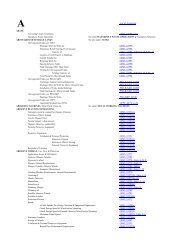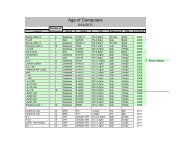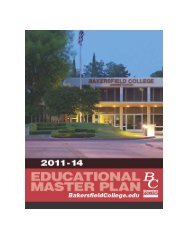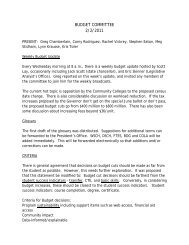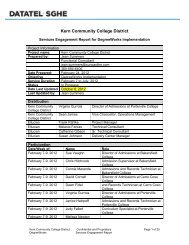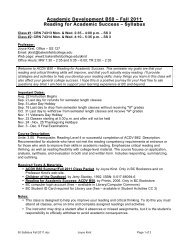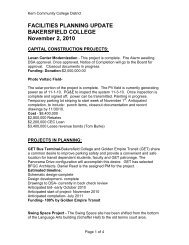Addendum with evidence (8.2 MB) - Accreditation - Bakersfield ...
Addendum with evidence (8.2 MB) - Accreditation - Bakersfield ...
Addendum with evidence (8.2 MB) - Accreditation - Bakersfield ...
You also want an ePaper? Increase the reach of your titles
YUMPU automatically turns print PDFs into web optimized ePapers that Google loves.
Determination of Future Space Needs<br />
Space Requirements for the Academic Program<br />
WSCH and Space Projections<br />
State standards for construction and renovation of facilities basically focus on capacity.<br />
Capacity, as outlined in the Facilities Planning Manual is correlated <strong>with</strong> the production of WSCH.<br />
WSCH represents the average number of hours of student instruction in a week per class (i.e. 30<br />
students enrolled in a class that meets 3 hours per week is 90 WSCH). Estimating growth in<br />
enrollments produces a factor of increased WSCH. This WSCH is then transformed into<br />
instructional space or assignable square feet (ASF). Each space type, in this case lecture and/or<br />
laboratory, WSCH generates an “appropriate” instructional facility addressed as ASF. While these<br />
calculations are established through state standards, other factors are considered in planning<br />
facilities. An additional factor in all planning is adequacy. Adequacy in this context assumes<br />
sufficient and/or suitable capacity to provide for an effective learning environment.<br />
Space Projections<br />
An assessment of the current facilities includes the capacity of the instructional program to<br />
meet programmatic needs, it reviews the condition of the facilities, and it addresses their adequacy<br />
to provide for an effective learning environment. The projections are not intended to dictate<br />
curricular content but rather to provide a perspective of what the current curriculum would look like<br />
if extended forward. The most important outcome of the forecasting process is to ensure that when a<br />
certain level of WSCH is achieved, the College will have in place designated and/or newly<br />
constructed facilities to meet demands in both academic and support services.<br />
Space Projections and the Future Program of Instruction<br />
The following table projects future space needs (ASF) in benchmark years 2015, 2020, and<br />
2025. The forecast is in summary form by instructional divisions of the College. The actual<br />
forecasting process, however, was conducted at the discipline/program level. A comprehensive<br />
analysis by discipline/program can be found in the Appendix of the Facilities Master Plan.<br />
108



